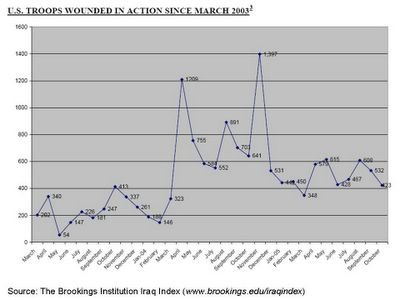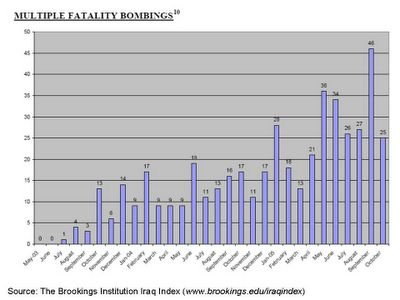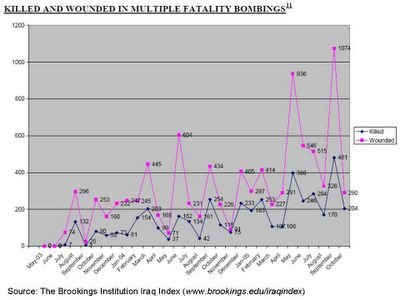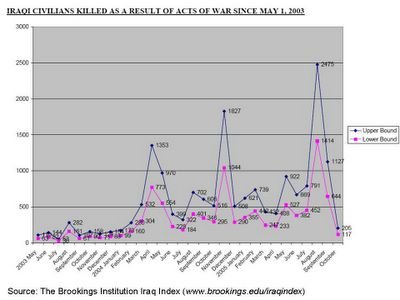A Grim Milestone and the Battle of Perceptions
This week, on the day that the Iraqi constitution passed, we reached 2,000 casualties.
From msnbc:
The U.S. military announced the death of an American soldier wounded in Iraq on Tuesday, bringing to 2,000 the number of American service members killed since the war started in 2003, according to an Associated Press count.
A Pentagon announcement Tuesday said Staff Sgt. George T. Alexander*** Jr., 34, of Killeen, Texas, was wounded by a roadside bomb north of Baghdad and died in San Antonio, Texas, last weekend. Earlier Tuesday, the military announced the deaths of two Marines in fighting with insurgents last week in a village west of Baghdad.
The reaction in some quarters of the blogosphere was predictable although some were more balanced.
All this happened the day after the insurgents staged a “made for TV event” by detonating car bombs outside hotels that house journalists in Baghdad. The blasts were caught on camera, and the images dominated the news cycle until the 2,000 dead mark was hit. The passage of the Iraqi Constitution was forced into the background, and any positive reports about the passage were qualified with statements about the deteriorating security situation.
Again, reaction to the situation has been predicable, and polling numbers show that support for the war is down, way down. But, are things as bad as they seem?
The following slides are from the The Brookings Institution's latest Iraq Index and an Iraqi Opinion Survey conducted in July by the International Republican Institute. The numbers in Iraqi Opinion survey are a bit dated, but they still seem to be a fairly good representation of what Iraqis think.
Here is the data:


Slides 1-2: US casualties are getting lower. There have been spikes in fatalities, but the number of US wounded indicates that the US casualty rate is down. Of course, this could just mean that the insurgents are going after different targets.

Slide 3: Casualties on Iraqi Police and Security forces appear to be slightly declining as well.



Slides 4-6: There has been a spike in bombings and civilian casualties in the month leading up to the constitutional referendum, but up until then, the numbers were trending down.


Slides 7-8: In July, even as the security situation was slightly improving, Iraqis main concern was security, and many appeared to believe that their country was moving in the wrong direction. The spike in attacks may off-set any positive feeling generated by the passage of the constitution.

However, Slide 9 reveals that Iraqi remain optimistic about the future--at least for now.
Analysis: What does it all mean? Despite the 2,000 dead mark, things are incrementally getting better in Iraq, but we’ve still got a long way to go. Things are bad but slowly getting better. Iraqis still believe in their own future, but the insurgents retain the power to influence the perceptions of the Iraqi, US, and international populations.
In the US, people are not seeing real progress or positive “metrics” on the situation. I shouldn’t have to tease data out of think-tank reports in order to make an argument about our successes. This is information that our government should be talking about with a loud voice. We need a better way to address these issues than the same old rhetoric about “staying the course” and endless invocations of 9-11. There has been much discussion about the lack of a US strategy in Iraq. Do we lack an effective strategy or do we lack an effective method of communicating it? Ditto for communicating with the international community.
In Iraq, public perception is important to victory. If Iraqi optimism can be bludgeoned out of them, the insurgents can still win. So it’s a matter of continuing to try and shape public perception in Iraq. The bad guys are good at it so we need to be just as effective. Time will tell who is better, but the insurgents have the cultural home field advantage.
Some bloggers and pundits have said that 2,000 is just an arbitrary number not to be emphasized. But, the “grim milestone” has impact both emotionally and rationally. Emotionally 2,000 dead Americans looks like failure. Without effectively communicating what those 2,000 lives have purchased with their sacrifice, Americans will loose their will to fight. You can blame whoever you want for this, but its reality.
Rationally 2,000 dead means the insurgents are still very much in the fight. They still have the freedom to act. They still have the initiative and some measure of support within the Iraqi population. They believe that they can drive us out of Iraq if they can kill enough of us, and they might be right. A true indicator of success will be if we can go an extended period of time without a loss of life. That will allow us to break the insurgent’s gory dominance of the news cycle, but sadly we’re still a considerable distance from that goal.
***Note: SGT Alexander, as far as I know, is not related to me.



4 Comments:
Kris, I think your interpretation of the figures is very questionable. I look at those casualty graphs and I see that September was terrible, and October was just bad. But I don't think you can claim that as a positive trend - especially not when many metrics appear worse than 6 months ago.
We've seen those kind of month-to-month variations often before - perhaps because US casualties rise when they mount an offensive (e.g. Fallujah) and drop when they stick to patrolling, and similarly Iraqi casualties depend on whether the insurgents are mounting a big effort or not. If you wanted to make a convincing case for a positive trend I think you would need a detailed statistical analysis and perhaps comparisons to patterns in other conflicts. I see a lot of noise, a certain amount of ebb and flow, but nothing encouraging.
I posted my response over here. Short version: these statistics are important to note, but they're far from the only important measure. That's no criticism of you, by the way, since you've done an excellent job publishing and analyzing the casualty numbers.
icasualties.org has substantially different casualty counts for the last two months: 96 in October and 79 in November (so far). That would fundamentally change the reading of those stats. Any idea why the difference?
Sorry, those numbers were for American soldiers killed (the first slide)
Post a Comment
<< Home